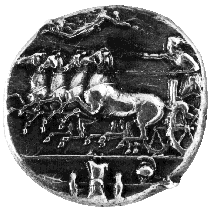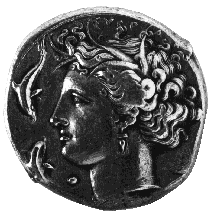



(19) Syracuse, Sicily (Italy) - AR dekadrachm, c. 400-370
B.C., 43.16 g. (inv. 91.032).
Obverse: Quadriga l., with Nike flying to crown
female charioteer; cuirass, helmet, shield,
and greaves in exergue.
Reverse: Head of Arethusa l., crowned with reeds, surrounded
by four dolphins; dot below chin; ![]() : of the Syracusans.
: of the Syracusans.
Provenance: Stack's, 1969.
Bibliography: A. Gallatin, Syracusan Dekadrachms of
the Euainetos Type (Cambridge 1930).
This coin is attributed to the artist Euainetos, who also signed dies for
the mint at Katane and whose types were imitated by the mints of numerous
other cities (see nos. 20, 21,
22). The dot on the reverse may mean that the die
was the work of an assistant imitating the original by Euainetos.
Euainetos transformed the traditional victorious quadriga of the obverse
of Syracusan coins by utilizing the techniques of foreshortening developed
in the last quarter of the fifth century. The horses are no longer in profile,
but in three-quarter view, as are the wheels of the quadriga. The
heads of the horses turn in various directions, and the charioteer hunches
over in racing form, a whip in her outstretched hand. The military equipment
in the exergue, also a feature of the dekadrachms of Kimon (see no. 18),
originally led numismatists to associate these coins with the Syracusan
victory over the Athenians in 413 B.C., but the coins are now generally
thought to date from the late fifth and early fourth centuries.
On the reverse, the Syracusan nymph Arethusa is depicted in the late fifth-century
Rich Style, her face delicately modelled, with great attention devoted to
minute details of her hair. Her wreath of reeds refers to her character
as a fresh water nymph.
K.S.



All contents copyright (c) 1996.
Lawrence University
All rights reserved.